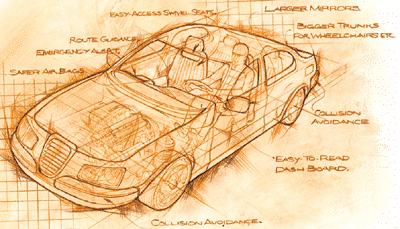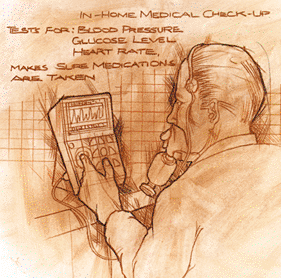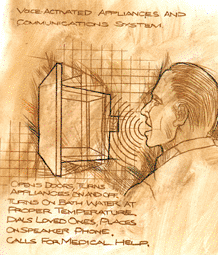New Age for the Elderly
By Joannie Fischer

Thanks to the billions of dollars now being directed toward medical research by the anxious agers, the average American born at the turn of the new millennium will inherit a life expectancy nearly twice as long as that of a person born in 1900. In fact, for the first time in history, notes Horace Deets, executive director of the American Association of Retired Persons, a given 50-year-old still has half of his or her adult years to live out.
With another one of the nearly 77 million baby boomers now turning 50 years old every seven seconds, the urgent question, says Deets, is: Now that we’ve added so many years to a life, how can we add more life to those years? It is a question that will be answered in large part by engineers.
With the ranks of those 65 years of age and older expected to swell from 33 million today to more than 80 million over the next four decades, there is a “natural marriage looming between technology and older people,” says Robert B. Hudson, editor of the Public Policy and Aging Report. For decades, he says, American society has expected older people, who were relatively few in number, to adjust to an environment designed for younger people. But with the first of the baby boomers set to hit the senior discount stage of life in about a decade, Hudson says it is time to adjust the infrastructure of everyday life to meet the needs of graying citizens, who already make up one in every six Americans and before the coming century’s end will account for one in every three.
Thanks to advances in nutrition and in the prevention and treatment of disease, most of us will remain much healthier and more active than senior citizens of the past. But even in the best case scenario, the natural aging process still causes changes that alter the way a person moves through life. Starting in our thirties, subtle but steady declines start to make a body weaker, perception less acute, and response times slower. That is why it is imperative, says Jeanette Takamura, head of the federal government’s Administration on Aging, for the government to “encourage the development of an architecture for longevity,” whether it be more accommodating traffic lights, remote communication systems for caregivers, or homes that 90-year-olds can more easily navigate.
It is not only the urgings of government leaders, but also the unprecedented purchasing power of the boomers that is helping to spawn the infant field of “gerontechnology,” also known as “eldertech.” Never has an aging population been so well educated, so wealthy, so eager to be active through the last days of life, and so willing to spend money on products and services to make that happen. Not only has the percentage of the elderly who are considered poor dropped from 30 percent to 10 percent over recent decades, but baby boomers are expected to inherit as much as $14 trillion, the largest transfer of wealth in history, according to MIT economist Lester Thurow.

An in-house remote caregiving system that can monitor vital signs might allow older people to remain independent for years.
Automobile manufacturers are responding to the desires of older consumers with new features, like night vision enhancements, that make it a little less frightening for a driver with less-than-perfect vision to take to the road. The University of North Carolina boasts a “Universal Design Center,” devoted to restructuring living spaces to make it easier for aging people to remain independent longer, “aging in place” at home rather than being institutionalized. And the Center for Assistive Technology at the University of Buffalo has developed dozens of products, from radios that turn on and off with the tilt of a head to coffee cups that beep when they are almost filled to the brim.
Engineers throughout the new gerontechnology field are considering not only the special needs of the elderly, but also those of the people who care for them. Today, more than seven million people act as informal caregivers to aging parents and relatives. Those figures will only mushroom, because the older a person gets, the more assistance he or she needs, and the numbers of the “oldest old”葉hose over 85謡ill quadruple over the next 50 years to reach nearly 20 million. That puts engineering innovations that will make it easier for the sandwich generation to care for their elders without losing control over their own lives. And with the combined earning power of caregivers and elders at $1.6 trillion, corporations such as Electronic Data Systems, Toyota, and Hartford Insurance are taking notice.
But nowhere is the effort to engineer a better life for the second half of life more front and center than at the new Technology for Healthy Aging Laboratory, at the Massachusetts Institute of Technology. Aimed at bringing together academics, government officials, private foundations, and industry leaders in partnerships to commercialize new innovations, the MIT Age Lab employs engineers, transportation specialists, and even physicians to brainstorm on improvements to all aspects of daily life.
Right now, the fledgling Age Lab looks like a big garage, but founder and director Joseph Coughlin hopes that soon it will grow into a large, multi-level facility with glass walls. The glass is key, he says, because until now, most technologies to help older folks have been developed in a piecemeal fashion that does not take a holistic approach to a person’s life. “A better bed is nice,” he says, “But how much good does it do overall if you never leave the bed because you have no transportation to get you out to see your friends and you’re isolated and depressed?” So Coughlin plans to have engineers who are developing better kitchens working just on the other side of the glass from those designing better telephones, and better cars, and better computers, so that everyone can feed off one another’s ideas and always keep the big picture in mind. In what Coughlin sees as a systems-engineering approach, MIT is focusing on new technologies to improve four key, intersecting arenas of life he home, transportation, communications, and the workplace.
Home Sweet Home
If the American dream is to own one’s own home, the older American’s dream is not to have to leave it behind. Sadly, many older adults who could have otherwise remained independent for years end up in hospitals and nursing homes after falls, often the result of poor lighting. Dr. Elias Reischel, professor of opthalmology at Tufts University School of Medicine and a visiting scientist to MIT’s Age Lab, has found that traditional night lights can do more harm than good, because they cast disorienting shadows at night. Likewise, normal lights, when first turned on, can “bleach” out vision, stunning the eye. So Reischel is working on variable frequency lighting that is automatic, sensitive to motion or to the voice, so that there is no need to fumble for a switch in the middle of the night.
In fact, voice activation can soon make it possible to run bath water that is just the right temperature, turn on the stove for tea and then turn it off again, and notify the computer to dial a loved one and place them on speaker phone, all without lifting a finger. Already, the concept called Universal Design is being applied to new homes that able-bodied boomers are buying up in hopes of staying put comfortably for decades. The American Association of Retired Persons is partnering with realtors to showcase homes that offer safety features built to be as unnoticeable as possible, such as grab bars that double as decorative towel racks. The special additions seem to be paying off. A study from the University of Buffalo’s Rehabilitation Engineering Research Center on Aging finds that people whose homes incorporate an array of safety devices rom grab bars to no-slip rugs揺ad fewer hospitalizations and used less in-home health care, saving money both for themselves and for society at large.
One of the most important features of a hospitable home for the elderly may be a computerized health care center, right in a living room or kitchen, that allows for what MIT engineers call “a checkup a day.” Each day, a resident could slip a finger or hand into contact with sensors that could measure vital signs such as blood pressure, glucose levels, and oxygen saturation in the blood. This information could be instantaneously transmitted to a doctor’s office, prompting a call from health care workers if anything is off. Similar technology could ensure that the proper medications have been taken at the right time.
Lifelong Transportation
Within three decades, the number of deaths caused by elderly drivers is expected to exceed those now caused by drunk drivers. But Coughlin believes there is a better solution than simply stealing the keys from aging parents. Because so much of the quality of living depends on the ability to get out to see favorite people and places, improving transportation options for the elderly is a key item on the eldertech agenda.

Wireless communication systems will be able to schedule transportation pick-ups and even track the location of a vehicle.
Older people who stop driving, studies show, are far more likely to become housebound, and to deteriorate because of it, so the first line of effort among age-related engineering is reinventing the automobile to make up for some of the physical and mental deficits inherent to aging.
For example, “intelligent transportation systems” already exist that can warn drivers of oncoming vehicles, and visual aides can help increase depth perception and make up for the older eye’s reduced ability to see contrasts and recover from the glare of sun or oncoming headlights. Collision warning systems can guide elders through intersections, where a great number of their accidents now happen. And “reversing assistance” technologies can help older drivers who find it tough to twist their necks far enough to gaze over their shoulders behind the car.
One of the main questions engineers are now asking is how to incorporate all these features into a single car without overwhelming the driver with too many beeps, buzzes, and flashes. And because no one, young or old, wants to drive their father’s Oldsmobile, a primary challenge for manufacturers is to incorporate new features in such a way that they don’t scream “old man’s car,” says Coughlin.
But no matter how many innovations the next generation of cars incorporates, many older citizens will become altogether unable to drive at some point. And with three quarters of the elderly living in rural or suburban areas where mass transit is not the norm, engineers both at MIT and at the Department of Transportation foresee a strong need for a new Community Transportation Vehicle. Similar to an airport shuttle, the CTV would be clearly recognized by all seniors, and in an ideal world, satellite systems and handheld computers would allow an older person to know exactly where the CTV is at any given time, and to easily schedule a pickup, with the push of a button or a voice command into a Palm Pilot-type device. Similarly, smart cards could be used in lieu of cash, to ease the process of paying.
The Workplace
Seven out of every 10 baby boomers say they plan to keep working, at least part time, after retirement. A better workplace, say ergonomics experts, would be more elder-friendly, with automatic doors, softer lighting, better acoustics, and more comfortable seating for older bodies. And because so many workers in their forties and fifties are distracted by eldercare concerns, stress over caregiving demands is reported to be the leading cause of depression among today’s workers. Technologies that would allow workers to monitor an aging relative on a desktop computer screen at the press of a button are already close to being released on the market.

While voice-activated appliances are likely to appeal to people of all ages, they will be particularly useful for the elderly.
Communications
It’s not so much flagging health that threatens seniors’ well-being as it is isolation. A lack of social contact is the number one predictor of an early death. No one, says Coughlin, goes to the local fast food joint for the watered down coffee. “Life only seems worth living if we can spend it with the ones we love.” Aging engineers envision tomorrow’s grandparents fully “wired,” so that relatives and health workers know at any given time where they are, how their health is, and whether they are in need of any assistance. “Ideally, these technologies would be all but invisible,” says Coughlin, who imagines rings that can sense blood pressure, sensors woven into clothing fabrics, talking watches, and necklace pendants that can transmit computerized images.
Bringing It All Together
Of course, because these realms are always intersecting and overlapping, the most useful technologies will incorporate them all. For example, Thomas B. Sheridan, director of MIT’s Human-Machine Systems lab, has partnered with Massachusetts General Hospital physician James M. Thompson to design a monitoring device for the 65 million Americans with chronic heart disease. The device can be tiny, in the form of a Band-Aid or a ring with a green light to show that it’s working to monitor pulse rate, temperature, and other vital signs. Periodically, it sends an electronic record of the person’s health status to hospitals.
When something goes wrong, rather than a patient wondering whether he should make a call for help, the computer can make the decision, transmit signals to call for an ambulance, and notify loved ones all at once. One of the best features about the experimental device, say Sheridan and Thompson, is its potential to reduce everyday stress for heart patients, who often wonder whether a symptom is serious or not. And because stress itself is a major risk for those with weak hearts, they note, the monitoring device can also play a role as a preventive health treatment.
As engineers know all too well, ingenious laboratory designs are one thing; widespread use is quite another. When Coughlin talks with foundations and industry about which technologies to most actively pursue, he uses the following “Three As” as a guide:
Availability. As futuristic as some of these technology designs are, there is already a great need for many of them today. One in every six Americans, some 44 million people, is 60 years of age or older. Four million are 85 or older. And one in four households is already involved in providing the primary care for elders who need assistance. So technologies that are already closer to reality, says Coughlin, should win out in the battle for research dollars over the loftiest pie-in-the-sky ideas.
Acceptability. Essential to the success of the new technologies is their desirability among the aging. Some of the new innovations, such as new machines that both wash and dry clothes, will be embraced by old and young alike. But others, such as the controversial “Nanny Cam” which allows people to monitor the movements of an elderly person in his or her own home, may prove unpalatable over time.
Affordability. It is not only important to opt for products that aren’t prohibitively expensive, but also to get products on the market quickly, Coughlin says, so that competitive forces can kick in to drive down prices. For example, voice recognition systems manufactured by IBM and others that cost up to $8,000 a few years ago have already dropped to less than $1,000.
Now just 38 years old, Coughlin says that his endeavors as the nation’s pioneer of engineering initiatives for the aged constitute his own personal form of social security. “Most of us are living in a state of denial about getting old,” he says. “Not me. When I get up there, I want to be able to do as much living as possible.” If his MIT team and their partners succeed, plenty of grateful cohorts are likely to be picking up his coffee tab in another 50 years.
Joannie Fischer is a freelance writer in Washington, D.C..
Category: Features
